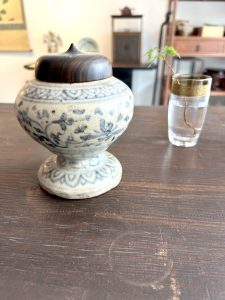形を変えて愛好されてきた香文化(愛知県名古屋市千種区姫池通 骨董買取 古美術風光舎)
2024.06.25
皆さまこんにちは。スタッフHでございます。
湿気の多い季節となりました。食中毒には要注意ですね。元々お腹は丈夫な方なのですが食べ物を持ち歩く時は保冷剤、酢、梅干しなどを多用しております。酸っぱいものは疲労回復効果もあり一石二鳥ではないでしょうか。
さて前回の香木の種類の解説に続き、今回は日本における香文化の歴史について時代の流れと共に綴りたいと思います。

―香文化の歴史―
飛鳥時代
香文化は仏教伝来と共に古墳時代の終わりから飛鳥時代にかけて中国から伝わったとされています。仏教儀式には欠かせないものとして東大寺や法隆寺などの大寺院で香が薫かれていました。また魔除け、厄除けなどの目的もあったようで奈良の正倉院には最古の香袋が収蔵されています。
平安時代
時を経て平安時代の貴族たちによって、香は宗教とは切り離され、日常を華やかに彩る「楽しむための香り」へと発展していきました。この時代に「練り香」が広まり、貴族たちは自ら香りを調合し自分だけの香りを作りました。練り香は沈香や白檀などの香木や丁子、貝香などを粉末状にし、密や梅肉などで丸薬状に練り固めたお香です。
衣服に香りを薫き染めることを「薫衣香(くのえこう)」、室内に香りを漂わせることを「空薫(そらだき)」と言いました。香りの優劣を争う「薫物合(たきものあわせ)」という遊びも流行し現代にも伝わる「六種の薫物(むくさのたきもの)」が生まれました。
端午の節句に薬玉(中に調合香を入れた球状のもの)が贈答に使われたり、また魔よけとしても利用したりと香は貴族たちの知性、感性、美意識を表現するものとして愛好されました。
鎌倉時代
平安時代末期より武士が台頭してくると、貴族たちが好んだ香料を調合した香りではなく、香木を焚くだけの「一木(いちぼく)の香り」が好まれるようになりました。香木の中でも「沈香」は爽やかな香りで鎮静効果に優れ、戦の前の高ぶる気持ちを鎮めるとして好まれました。
鎌倉時代末期から室町時代にかけて、武士の嗜好や美意識は香木の価値を高め、香木の香りを聞き分ける「闘香」という遊びが公家や武家の間で流行しました。現在の「香道」で行われている「聞香(もんこう)」や「組香(くみこう)」に繋がっていったと考えられています。
室町時代
室町時代は新たな文化へと変貌する時代でもありました。8代将軍の足利義政は東山山荘を拠点に花開いた東山文化の立役者として文化、芸術、建築など多くの日本文化を発展させました。後に芸道となる「香道」の体系づくりのため、香道の二代流派の祖である三条西実隆や志野宗信らに命じて香道の基礎となる一定の作法やルールを作りました。
それぞれの香木を分類整理し、香りを客観的に表現する「六国五味(りっこくごみ)」という香りの分類法もこの頃に体系づけられました。
六国とは香木を産出地名などから伽羅・羅国・真南蛮・真那伽・佐曽羅・寸門陀羅に分類したもので、さらにその香りを甘・辛・酸・苦・鹹(しおからい)という味で表現するものです。
三條西実隆は香道の「御家流(おいえりゅう)」の流祖で和歌や古典の貴族文化を発展させた人物です。そのためこちらの流派は貴族、公家の流儀とされています。
志野宗信は香道の「志野流」の流祖で、6代足利義教から8代足利義政まで仕えました。現在は愛知県尾張に居を構え、武家社会のしきたりを継承する「武家の流派」ともいわれ、香道を通して精神を鍛錬することに重きをおくとされています。
この「志野流」と「御家流」が二代流派として現代にまで受け継がれています。
江戸時代
太平の世が続く中、香は武士や大名貴族だけでなく、豪族や町人の間にも広まります。この時代に沈香の中でも最高品質の「伽羅」は極上品のとして人気を博しました。長崎の出島にオランダ船が入港する時は諸国の大名が上質の香木を求めたと伝えられています。
そして現代の「香道」における香作法の基礎がほぼ完成し武家社会に浸透していきました。家元制度も確立され18世紀には香道を嗜む人口は急増していきました。
明治時代
明治維新の文明開化の流れの中で、香道は衰退する時期を迎えますが、幾多の戦火をくぐり抜け、日本独自の伝統文化として現代まで絶えることなく伝承されています。
現代の慌ただしい日常の中で、香りによる癒し効果を求め日常生活に取り入れる人々が増えています。日本人にはやはり昔ながらの「お香」の香りが馴染むのではないでしょうか。
最近では国際的でも「香道」が注目を集め香席のイベントが開催されているとのこと。
貴重な香木を用いて「香道」という芸道に昇華し伝承してきた日本文化に敬意を払い、次回は香道の作法やお道具について綴りたいと思います。よければお付き合いください。
それでは、また次の機会に。

Hello everyone. This is Staff H.
It is the season of high humidity. We need to be careful about food poisoning. I have a strong stomach by nature, but when I carry around food, I use a lot of cooling agents, vinegar, and pickled plums. Sour food also relieves fatigue, killing two birds with one stone, don’t you think?
Following the explanation of the types of fragrant woods in the previous article, this time I would like to write about the history of the incense culture in Japan over time.
-History of Incense Culture
Asuka Period
It is said that the incense culture was introduced from China from the end of the Kofun period to the Asuka period, along with the introduction of Buddhism. Incense was smoked at large temples such as Todai-ji and Horyu-ji as an essential part of Buddhist ceremonies. It was also used to ward off evil spirits and misfortune, and the oldest incense pouch is stored in the Shosoin Repository in Nara.
Heian Period
As time went by, incense was separated from religion by the aristocrats of the Heian period and developed into a “fragrance for enjoyment” to add color to daily life. During this period, “kneaded incense” became widespread, and aristocrats created their own unique fragrances by mixing their own fragrances. Kneaded incense is incense made from agarwood, sandalwood, and other aromatic woods, as well as clove and shell incense, in powder form, and then kneaded into a pill-like shape with densely packed plum paste and other ingredients.
The term “kunoe-ko” was used to describe the fragrance applied to clothing, while “soradaki” was used to describe the fragrance wafted into a room. The game of “takimonoawase,” in which contestants competed for the best fragrance, also became popular, giving rise to “mukusa no takimono,” or six kinds of fragrances, which have been handed down to the present day. In this way, incense was loved by the nobility as an expression of their intelligence, sensitivity, and sense of beauty.
Kamakura Period
As samurai warriors came to power in the late Heian period (794-1185), people began to prefer the fragrance of “ichiboku,” which is simply burning fragrant wood, rather than the mixed fragrance favored by the aristocrats. Among fragrant woods, agarwood, with its fresh fragrance and excellent calming effect, was favored for its ability to soothe the high spirits before a battle.
From the end of the Kamakura period (1185-1333) to the Muromachi period (1333-1573), the tastes and aesthetic sense of the samurai elevated the value of fragrant woods, and a game called “fighting incense” to distinguish the fragrance of fragrant woods became popular among court nobles and samurai. It is believed to have led to the “monkou” and “kumikou” practices that are practiced today in “kodo” (the way of incense).
Muromachi Period
The Muromachi period (1333-1573) was also a time of new cultural developments, and Ashikaga Yoshimasa, the 8th shogun, was a leading figure in the Higashiyama Culture, which flourished at his villa in Higashiyama, and developed many aspects of Japanese culture, including culture, art, and architecture. In order to create a system of “Kodo,” which later became an art form, he ordered Sanjonishi Sanetaka and Shino Munenobu, the founders of the second generation of Kodo schools, to establish certain rules and manners that would serve as the foundation of Kodo.
Sanjonishi Sanetaka was the founder of the Oie school of incense, which developed the aristocratic culture of waka poetry and classics. This school is therefore considered to be the style of aristocrats and court nobles.
Shino Munenobu was the founder of the Shino school of incense, and served from Ashikaga Yoshinori, the 6th Ashikaga Yoshinori, to Ashikaga Yoshimasa, the 8th Ashikaga Yoshimasa. He currently resides in Owari, Aichi Prefecture, where he continues the tradition of samurai society.
The “Shino school” and the “Oke school” have been passed down to the present day as two generations of the Shino school.
Edo Period
As the peaceful times continued, incense spread not only among warriors, feudal lords and aristocrats, but also among powerful families and merchants. During this period, “Kyara”, the highest quality of agarwood, became popular as the finest. It is said that when Dutch ships arrived at Dejima Island in Nagasaki, feudal lords from all over the world sought the best quality fragrant wood.
The foundation of the modern “kodo” art of incense production was almost completed and penetrated into the samurai society. The Iemoto system was established, and by the 18th century, the number of people who enjoyed the art of kodo was rapidly increasing.
The Meiji Era
However, Kodo has survived the fires of war and has been handed down to the present day as a uniquely Japanese traditional culture.
In today’s hectic lifestyle, more and more people are seeking the healing effects of fragrance and incorporating it into their daily lives. Japanese people are probably more familiar with the traditional aroma of incense.
Recently, “Kodo” has been attracting attention internationally, and events for incense seating are being held.
In my next entry, I would like to write about the manners and tools of Kodo, paying respect to the Japanese culture that has sublimated and handed down the art of “Kodo” using precious fragrant woods. Please bear with me if you like.
Until next time.
*******************
ご実家の整理やお片付けなどをされている方のご相談などが多くございます。
お片付けなどくれぐれもご無理のないようになさってくださいませ。
風光舎では古美術品や骨董品の他にも絵画や宝石、趣味のお品など様々なジャンルのものを買受しております。
お片付けをされていて、こういうものでもいいのかしらと迷われているものでも、どうぞお気軽にご相談下さいませ。
また風光舎は、出張買取も強化しております。ご近所はもちろん、愛知県内、岐阜県、三重県その他の県へも出張いたします。
まずは、お電話お待ちしております。
愛知県名古屋市千種区姫池通
骨董 買取【古美術 風光舎 名古屋店】
TEL052(734)8444
10:00-18:00 OPEN

